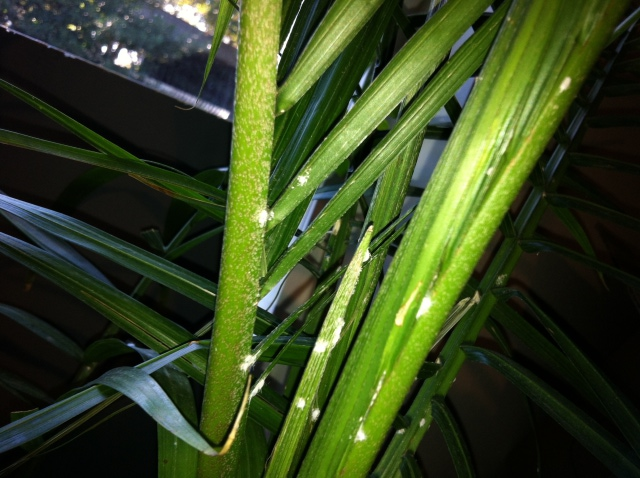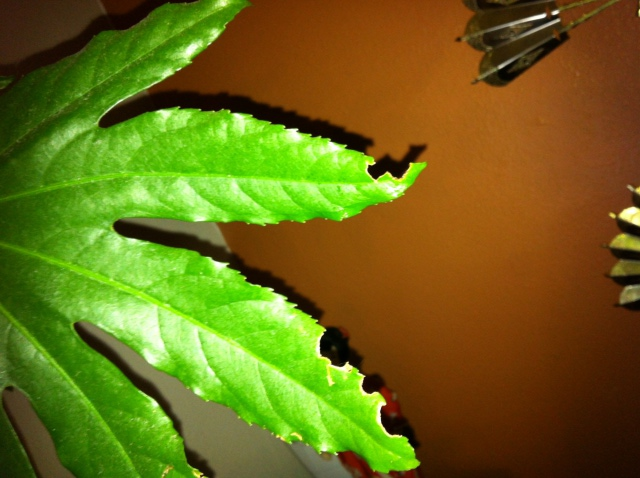Question
 Palm
Palm  ? Japanese tree
? Japanese tree
I have a ton of house plants and they all seem to be dying in one way or another. I recently moved and have never had any major problems till now. I repotted this first plant which is a palm tree type about 4 months ago and was doing fine in partial sunlight sitting on the side where the sun rises so most of its sun is in the very early am. There seem to be this white stuff all over it. It came quickly and is in between the stalk stems and on some of the leaves and it is dying rather quickly.
The second plant is a hearty one( not sure the name) but leaves seem to be being eaten in patches through the middle or at ends but cannot see any bugs. Sits on the west end so receives early evening sun and repotted about a year ago, because does not like to be bothered and has grown beautiful since moving. This same thing is also on a few other of my plants.
Please help me identify what is going on and what I can do to fix it.
Thank you
AnswerHi Starshine,
Relocating plants often leads to plant problems. Plants do not like change and any change in light requires adjustments in watering. Repotting further adds to the stress of plants. So it is not too surprising that many of your plants are struggling right now.
Your Chamaedorea (Bamboo) Palm is infested with mealybugs. The mealybugs were probably there in very low numbers when you acquired it, but now that it is under stress for other reasons (repotting, inadequate light and perhaps improper watering), the mealybugs are taking advantage and thriving. Check all nearby plants for early signs of mealybugs - typically tiny cotton-like bits on leaves.
To treat mealybugs, mix a solution of 5 parts water, 1 part alcohol and a squirt of liquid dish soap. Then, thoroughly spray the entire plant so that all leaf and stem surfaces are dripping wet with this solution. If you fail to make direct contact with even a few of the mealies, then they will reproduce and return again in a few months. This is a messy process best done outdoors.
Your Palm should get 2-4 hours of direct sun each day and lots of bright light for the rest of the day. Directly in front of an east window is a good location as long as the window is completely uncovered. Allow the top quarter of the soil to dry before watering. Add only enough water so that it reaches that level of dryness again in about a week. You have to be very careful not to overwater because of the recent repotting.
It looks like the other plant is a Fatsia Japonica, sometimes called Japanese Aralia, but I cannot be sure without seeing a photo of the entire plant. I also cannot see the extent of the chewing damage. Is it one leaf or many leaves? Normal indoor plant pests do not chew leaves in that manner. I suspect it is a type of chewing insect normally found outside. If your plants were outside for a while that may be the source. Chewing insects are relatively large and easy to see, so if you do not see any, then there is not likely to be further damage. A thorough spraying of the plant with a strong hose spray should knock any such insects loose.
I have written detailed articles on indoor plant pests and on Palm care that I will email for free to you (or anyone else) who emails a request to me at
[email protected]. I have also written an indoor plant care book in a PDF format that I can sell you if you contact me at my email address.
Please let me know if any of this is unclear or if you have any additional questions.
If this information has been helpful, please click the Rate Volunteer bar below and enter a rating and NOMINATION for me. I am a volunteer on this site so Ratings are the only compensation I receive for answering plant questions.
Need more information? Visit my website at:
A link to HorticulturalHelp.com
or email me at
[email protected] or call me at 917-887-8601 (EST)
Regards,
Will Creed, Interior Landscaper
Horticultural Help, NYC
Visit my website at: A link to HorticulturalHelp.com







